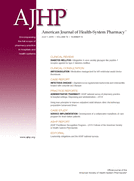-
Views
-
Cite
Cite
Craig A. Pedersen, Philip J. Schneider, Douglas J. Scheckelhoff, ASHP national survey of pharmacy practice in hospital settings: Dispensing and administration—2014, American Journal of Health-System Pharmacy, Volume 72, Issue 13, 1 July 2015, Pages 1119–1137, https://doi.org/10.2146/ajhp150032
Close - Share Icon Share
Abstract
The results of the 2014 ASHP national survey of pharmacy practice in hospital settings that pertain to dispensing and administration are described.
A stratified random sample of pharmacy directors at 1435 general and children’s medical–surgical hospitals in the United States were surveyed by mail.
In this national probability sample survey, the response rate was 29.7%. Ninety-seven percent of hospitals used automated dispensing cabinets in their medication distribution systems, 65.7% of which used individually secured lidded pockets as the predominant configuration. Overall, 44.8% of hospitals used some form of machine-readable coding to verify doses before dispensing in the pharmacy. Overall, 65% of hospital pharmacy departments reported having a cleanroom compliant with United States Pharmacopeia chapter 797. Pharmacists reviewed and approved all medication orders before the first dose was administered, either onsite or by remote order view, except in procedure areas and emergency situations, in 81.2% of hospitals. Adoption rates of electronic health information have rapidly increased, with the widespread use of electronic health records, computer prescriber order entry, barcodes, and smart pumps. Overall, 31.4% of hospitals had pharmacists practicing in ambulatory or primary care clinics. Transitions-of-care services offered by the pharmacy department have generally increased since 2012. Discharge prescription services increased from 11.8% of hospitals in 2012 to 21.5% in 2014. Approximately 15% of hospitals outsourced pharmacy management operations to a contract pharmacy services provider, an increase from 8% in 2011.
Health-system pharmacists continue to have a positive impact on improving healthcare through programs that improve the efficiency, safety, and clinical outcomes of medication use in health systems.






Comments